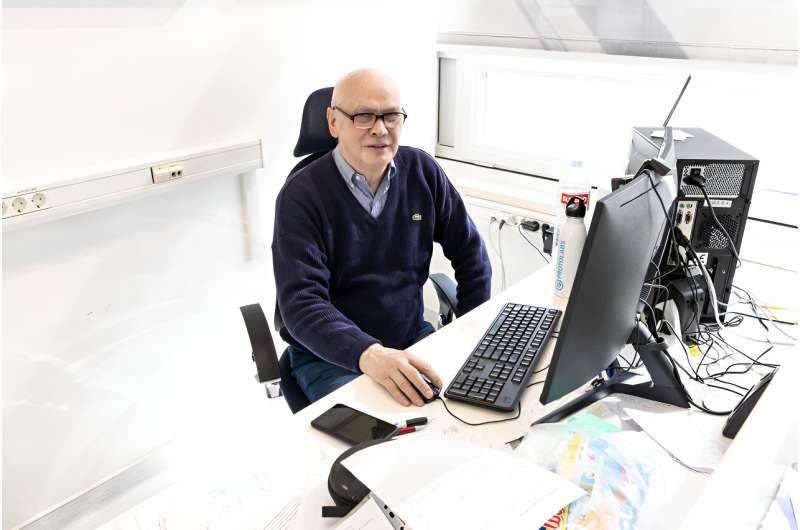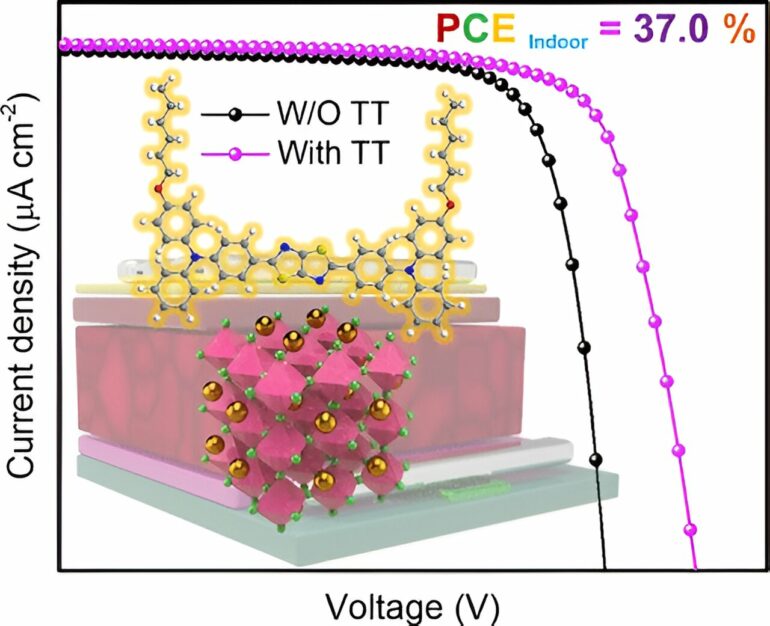Chemists at Kaunas University of Technology (KTU), Lithuania have synthesized materials that can improve solar elements for indoor use. Such photovoltaic cells, which can also be integrated into various electronic devices, generate electricity even in low-light conditions.
Their study is published in ACS Applied Materials & Interfaces.
Consumption of oil and gas results in an increase of atmospheric temperatures, leading to global climate change, currently labeled a climate crisis. To combat this problem, efforts are being made to use renewable and environmentally friendly energy sources such as wind, water and solar power.
“Wind and hydro energy are constrained by high costs and location dependency, while solar energy is flexible, efficient and relatively inexpensive. However, the energy from indoor light sources and natural light entering through windows is lost every day,” says Juozas Vidas Gražulevičius, Professor at the KTU Faculty of Chemical Technology and Head of the Chemistry of Materials research group.
According to Prof. Gražulevičius, this can be solved by indoor photovoltaics, which generate electricity even in low-intensity light conditions.

Prof. Juozas Vidas Gražulevičius, KTU Faculty of Chemical Technology. © Kaunas University of Technology
A clear market niche for efficient indoor solar cells
“Perovskite photovoltaic cells for indoor use can be integrated into mobile phones, pocket flashlights and other electronic devices; they can generate electricity under artificial light. Using Internet of Things (IoT) technologies, this electricity can be used to efficiently regulate the operation of devices and optimize energy consumption,” says Dr. Asta Dabulienė, Senior Researcher at the Chemistry of Materials research group, KTU.
With the rapid development of IoT technologies, the market for photovoltaic cells for indoor use has expanded significantly. High-performance, low-cost and versatile indoor PV cells are therefore the key to filling this market gap.
Dr. Dabulienė has synthesized a series of new efficient hole-transporting thiazol[5,4-d]thiazole derivatives for indoor perovskite photovoltaic cells. The main function of their layers is to selectively transport holes (positive charge carriers) while blocking electrons (negative charge carriers). This selective charge transport helps in reducing recombination losses, thereby improving the overall efficiency of the solar cell.
“An ideal hole transporting semiconductor for these applications would possess high hole mobility and good energy level alignment with those of adjacent layers,” explains dr. Dabulienė.
A thiazol[5,4-d]thiazole derivative containing a triphenylamine donor fragment, synthesized by KTU researcher Dr. Dabulienė, has been used by a research team at Ming Chi University of Technology (Taiwan) to develop perovskite solar cells for indoor use. The KTU-developed organic semiconductor allowed it to reach a power conversion efficiency of 37.0% under 3000 K LED (1,000 lx) illumination. Studies have shown the great potential of thiazol[5,4-d]thiazole derivatives for increasing the efficiency of perovskite solar cells.
The proposed innovation for indoor solar cells is the result of the work of an international team of scientists. Researchers from the KTU Chemistry of Materials research group have developed and synthesized organic semiconductors that efficiently transport positive charges and studied their properties.
The theoretical studies of the new compounds were carried out by scientists from King Abdullah University of Science and Technology (Saudi Arabia). Researchers at Ming Chi University of Technology in Taiwan have constructed and characterized perovskite solar cells for indoor use.
More information:
Asta Dabuliene et al, Enhancement of Efficiency of Perovskite Solar Cells with Hole-Selective Layers of Rationally Designed Thiazolo[5,4-d]thiazole Derivatives, ACS Applied Materials & Interfaces (2024). DOI: 10.1021/acsami.4c04105
Provided by
Kaunas University of Technology
Citation:
Scientists’ innovation for indoor solar cells maximizes the use of light energy (2024, July 25)



